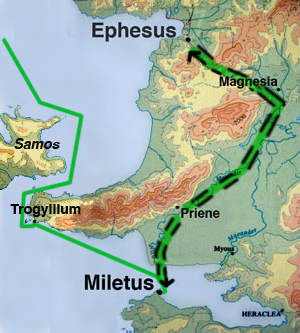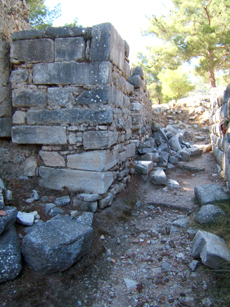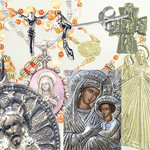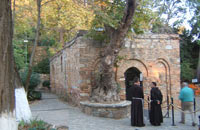Journeys with an Apostle –
Third Mission
Paul at Ephesus
Derring-do or hocus pocus?
Acts of the Apostles, together with Eusebius’ History of the Church – the primary documents of early church history – present a fake history, crafted to tell an uplifting story of how “The Way”, a marginal sect within Judaism, became “The Church”, a universal brotherhood of Christian fellowships spread far and wide. The pivotal figure in this glorious revolution was purportedly the apostle Paul and the climax to the story has the superlative missionary raising the glorious banner of Christ in Rome itself.
Strange happenings in Ephesus
Paul's "third missionary journey"

Hanky Panky
Ripping Yarn
Rattling the Silver
Return trip
Boat sails, Paul walks, pigs fly


Paul goes walkabout at Troas – Lord knows why!
Sailing by AND summoning the Elders?
You bet!
View across Lake Bafa from ruins of Heraclea/ Latmos. >>


Reality check – Roman Asia, scant evidence of 'prevailing might of the Word'

False Memory Syndrome
– R. Wilken, The Myth of Christian Beginnings, passim.
Sources:
- Ilhan Aksit, Lycia (Aksit Culture and Tourism, 1993)
- Bart Ehrman, Peter, Paul and Mary Magdalene (OUP, 2006)
- J. Stobart, The Glory that was Greece (Sidgwick & Jackson, 1964)
- W. Keller, The Bible as History (Hodder & Stoughton, 1969)
- A. Woods, Paul of Tarsus, an Enigma Enshrouded in a Mystery (Woods, 2005)
- J. Murphy-O’Connor, Paul, a Critical Life (Clarendon, 1996)
- J. Finegan, Light from the Ancient Past (Kessinger, 2007)
- A.N. Wilson, Paul-The Mind of the Apostle (Sinclair-Stevenson, 1997)
- Hermann Detering, The Falsified Paul, Early Christianity in the Twilight (Journal of Higher Criticism, 2003)
Related Articles:

The Great Theatre, Ephesus
3rd Mission in about 100 words?

Evidence of Jews in Ephesus – Graffiti! Wow!


Assimilating Jews of Miletus

Artemision


The Darkness starts here

Aphrodisias – Magnificent city of marble, victim of Christianity
The triumph of Christianity was a disaster for Aphrodisias. The Christians ended the market for classical sculpture and renamed the defiantly pagan city “Stavropolis”, City of the Cross. Terminal decline followed,


Miletus – a peninsula city

The harbour theatre, Miletus

Oracle of Apollo

Ancient Priene – vandalised by Christians
In the 5th century this crudely built “Bishop’s Church” displaced the bathhouse. The building ignored the ancient alignment of streets and – as seen here – reduced the Roman road to a narrow alleyway. Welcome to the Dark Age.


Self -financing Laodicea

Paul's preaching – a threat to trinkets? No kidding!

House of Mary Mother of Jesus at Ephesus?
